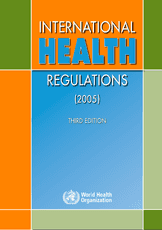International Health Regulations (IHR) 2005
The International Health Regulations (IHR) 2005 are a legally binding agreement designed to facilitate rapid identification and response to public health emergencies. Under the IHR, all 196 states parties must be capable of detecting, assessing, reporting and responding to disease outbreaks. Countries are also required to establish a reporting framework that ensures a national representative (the “IHR National Focal Point”) that can notify the World Health Organization (WHO) of a potential Public Health Emergency of International Concern (PHEIC) within 24 hours of its identification. To facilitate these capacities, countries are supposed to provide one another technical and financial support to develop core capacities, and conduct self assessments.
| Opened for signature | 23 May 2005 |
| Entered into force | 15 Jun 2007 |
| Latest update | 1 Jan 2016 |
| Available languages |
Related treaties
States parties
The Revised IHR (2005) were adopted at the 58th World Health Assembly on May 23, 2005. They entered into force for all WHO Member states on 15 June 2007, except for the following: India (8 Aug 2007), Liechtenstein (28 March 2012), Montenegro (5 February 2008), South Sudan (16 April 2013), and the USA (18 July 2007). Download the data in this table to view any reservations, understandings, and declarations (RUDs).
Country | Status | Signed | Ratified | Entered into force |
|---|---|---|---|---|
| Afghanistan | Party | 15 Jun 2007 | ||
| Albania | Party | 15 Jun 2007 | ||
| Algeria | Party | 15 Jun 2007 | ||
| Andorra | Party | 15 Jun 2007 | ||
| Angola | Party | 15 Jun 2007 | ||
| Antigua and Barbuda | Party | 15 Jun 2007 | ||
| Argentina | Party | 15 Jun 2007 | ||
| Armenia | Party | 15 Jun 2007 | ||
| Australia | Party | 15 Jun 2007 | ||
| Austria | Party | 15 Jun 2007 |
Party
The state has accepted, approved, ratified, or is otherwise party to the agreement, indicating consent to be bound to the agreement.
Signatory
The state has signed, but not yet ratified or become an official party to the agreement. Where the signature is subject to ratification, acceptance or approval, the signature does not establish the consent to be bound. However, it is a means of authentication and expresses the willingness of the signatory state to continue the treaty-making process. The signature qualifies the signatory state to proceed to ratification, acceptance or approval. It also creates an obligation to refrain, in good faith, from acts that would defeat the object and the purpose of the agreement.
Non-party
The state has not taken any actions with regard to the agreement.
Associate member
The state may have requirements for some of the statutory or non statutory aspects of an agreement, but would not confer all of the obligations of the agreement on the member. Associate members may not have voting rights.
Observer
The state is non-party to an agreement, but has the ability to attend meetings or other discussions, and otherwise participate in activities. Observers may be granted permission to speak at formal meetings.




